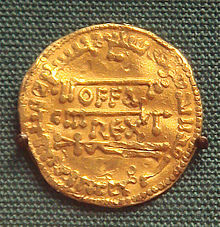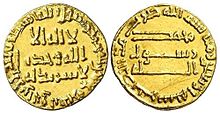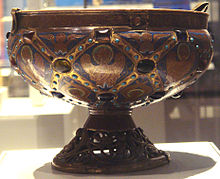Pseudo-Kufic
Right image: at the top, detail of the Virgin's mantle hem inAntonio Vivarini'sSaint Louis de Toulouse,1450. At the bottom, detail of Virgin's mantle hem inJacopo Bellini'sVirgin of Humility,1440.Louvre Museum.
Pseudo-Kufic,orKufesque,also sometimespseudo-Arabic,[1]is a style of decoration used during theMiddle Agesand theRenaissance,[2]consisting of imitations of theArabic script,especiallyKufic,made in a non-Arabic context: "Imitations of Arabic in European art are often described as pseudo-Kufic, borrowing the term for an Arabic script that emphasizes straight and angular strokes, and is most commonly used in Islamic architectural decoration".[3]Pseudo-Kufic appears especially often inRenaissance artin depictions of people from theHoly Land,particularly theVirgin Mary.It is an example ofIslamic influences on Western art.
Early examples
[edit]
Abbasid Dinar for comparison:



Some of the first imitations of the Kufic script go back to the 8th century when the English KingOffa(r. 757–796) produced gold coins imitating Islamicdinars.These coins were copies of anAbbasiddinar struck in 774 by CaliphAl-Mansur,with "Offa Rex" centred on the reverse. It is clear that the moneyer had no understanding ofArabicas the Arabic text contains many errors. The coin may have been produced in order to trade withAl-Andalus;or it may be part of the annual payment of 365mancusesthat Offa promised to Rome.[4]
In Medieval southernItaly(in merchant cities such asAmalfiandSalerno) from the mid-10th century, imitations of Arabic coins, calledtarì,were widespread but only used illegible pseudo-Kufic script.[5][6][7]
Medieval Iberia was especially rich in architectural decorations featuring both pseudo-Kufic and pseudo-Arabic designs,[2]largely because of the presence ofIslamic states on the peninsula.TheIglesia de San Román(consecrated in 1221) inToledoincluded both (real) Latin and pseudo-Arabic (i.e., notKuficstyle) inscriptions as decorative elements. The additions ofPedro Iof Castile and León to theAlcazar of Seville(mid-14th century) bear pseudo-Kufic design elements reminiscent of theAlhambrain Granada, and the metal facade of the main doors to theCathedral of Seville(completed 1506) include arabesque and pseudo-Kufic design elements. Such decorative elements addressed both social realities and aesthetic tastes: The presence of many Arabized Christians in many of these otherwise Christian states, and a general appreciation among the Christian aristocracy for Islamic high culture of the time.
Examples are known of the incorporation of Kufic script and Islamic-inspired colourful diamond-shaped designs such as a 13th FrenchLimoges enamelciboriumat theBritish Museum.[8]The band in pseudo-Kufic script "was a recurrent ornamental feature inLimogesand had long been adopted inAquitaine".[9]
-
Pseudo-Arabic (i.e. not Kufic style) surrounding an interior window of the Church of San Román, Toledo, Spain (c. 1221)
-
Decoration from a wall in the Alcázar of Seville (c. 1350), showing a band of pseudo-Kufic decoration meant to mimic decorations in the Alhambra
-
Part of the metal facade on the main door to the Cathedral of Seville (c. 1500), showing both arabesque and pseudo-Kufic design elements
Renaissance painting
[edit]| Part ofa serieson |
| Arabic culture |
|---|
 |
Numerous instances of pseudo-Kufic are known from European art from around the 10th to the 15th century. Pseudo-Kufic inscriptions were often used as decorative bands in the architecture ofByzantineGreecefrom the mid 11th century to mid-12th century, and in decorative bands around religious scenes in French and German wall paintings from the mid-12th to mid-13th century, as well as in contemporary manuscript illuminations.[10]Pseudo-Kufic would also be used as writing or as decorative elements in textiles, religioushalosor frames.[11]Many are visible in the paintings ofGiotto(c. 1267 – 1337).[3]
From 1300 to 1600, according to Rosamond Mack, the Italian imitations of Arabic script tend to rely on cursive Arabic rather than Kufic, and therefore should better be designated by the more generalist term of "pseudo-Arabic".[3]The habit of representing gilt halos decorated with pseudo-Kufic script seems to have disappeared in 1350, but was revived around 1420 with the work of painters such asGentile da Fabriano,who was probably responding to artistic influence inFlorence,orMasaccio,who was influenced by Gentile, although his own script was "jagged and clumsy", as well asGiovanni ToscaniorFra Angelico,in a moreGothicstyle.[12]
From around 1450, northern Italian artists also started to incorporate pseudo-Islamic decorative devices in their paintings.Francesco Squarcionestarted the trend in 1455, and he was soon followed by his main pupil,Andrea Mantegna.In the 1456–1459San Zeno Altarpiece,Mantegna combines pseudo-Islamic script in halos and garment hems (see detail), to depiction ofMamlukbook-bindings in the hand of San Zeno (see detail), and even to a Turkish carpet at the feet of the Virgin Mary (see detail).[13]
The exact reason for the incorporation of pseudo-Kufic or pseudo-Arabic in Medieval or early Renaissance painting is unclear. It seems that Westerners mistakenly associated 13-14th century Middle-Eastern scripts as being identical with the scripts current duringJesus's time, and thus found natural to represent early Christians in association with them:[14]"In Renaissance art, pseudo-Kufic script was used to decorate the costumes ofOld Testamentheroes like David ".[15]Another reason might be that artist wished to express a cultural universality for the Christian faith, by blending together various written languages, at a time when the church had strong international ambitions.[16]
Pseudo-Hebrewis also sometimes seen,[17]as in themosaicsat the back of the apse and the base of the dome inMarco Marziale'sCircumcision,which do not use actual Hebrew characters.[18]It was especially common in German works.
Finally pseudo-Arabic elements became rare after the second decade of the 16th century.[19]According to Rosamond Mack: "The Eastern scripts, garments, and halos disappeared when the Italians viewed the Early Christian era in an antiqueRomancontext. "[19]
-
Pseudo-Kufic on the veil of the Virgin,Ugolino di Nerio,c. 1315–1320
-
Pseudo-Kufic mantle hem, inPaolo Veneziano'sVirgin Mary and Child,1358.Louvre Museum
-
Pseudo-Arabic script in theVirgin Mary'shalo,detail ofAdoration of the Magi(1423) byGentile da Fabriano.The script is further divided byrosetteslike those onMamlukdishes.[20]
-
Pseudo-Arabic on the Christ Child's blanket, by Gentile da Fabriano[22]
-
Virgin with aGothicizingpseudo-Arabic halo, byFra Angelico(c. 1428–1430)
-
The Virgin Mary inAndrea Mantegna'sSan Zeno Altarpiececombines pseudo-Arabic halos and garment hems, with a Turkish carpet at her feet (c. 1456–1459).
Gallery
[edit]-
Pseudo-Kufic on garments inHenri Bellechose'sLe Retable de Saint Denis,c. 1415–1416
-
Virgin of Humility, adored by a prince of the House of EstebyJacopo Bellini,1440, with pseudo-Kufic mantle hem, but halo in Roman script.Louvre Museum
-
Pseudo-Kufic halo, inAntonio Vivarini'sSaint Louis de Toulouse,1450. Louvre Museum
-
Pseudo-Kufic hem inGiovanni Bellini'sLe Christ Bénissant,c. 1465–1470. Louvre Museum
-
Early-16th-centuryAndalusiandish with pseudo-Arabic script around the edge, excavated in London.Museum of London
See also
[edit]- Pseudo-Hebrew
- Asemic writing– Wordless open semantic form of writing
- Islamic contributions to Medieval Europe
- Islamic influences on Christian art
- Oriental carpets in Renaissance painting
- Mongol elements in Western medieval art
Notes
[edit]- ^Robbert Woltering (2011),"Pseudo-Arabic",in Lutz Edzard and Rudolf de Jong (eds.),Encyclopedia of Arabic Language and Linguistics(Brill), consulted online on 14 October 2023.
- ^abEncyclopaedia Britannica.Beautiful Gibberish: Fake Arabic in Medieval and Renaissance Art
- ^abcMack, p.51
- ^Medieval European Coinageby Philip Grierson p.330
- ^Cardini, p.26
- ^Grierson, p.3
- ^Matthew, p.240
- ^British Museumexhibit
- ^abLouvre museum noticeArchived2011-06-15 at theWayback Machine
- ^Mack, p.68
- ^"Beautiful Gibberish: Fake Arabic in Medieval and Renaissance Art".Encyclopedia Britannica.Retrieved2017-05-30.
- ^Mack, p.64-66
- ^Mack, p.67
- ^Mack, p.52, p.69
- ^Freider. p.84
- ^"Perhaps they marked the imagery of a universal faith, an artistic intention consistent with the Church's contemporary international program." Mack, p.69
- ^Mack, p. 62
- ^National GalleryArchived2009-05-07 at theWayback Machine
- ^abMack, p.71
- ^Mack, p.65-66
- ^Mack, p.66
- ^Mack, p.61-62
References
[edit]- Braden K. FriederChivalry & the perfect prince: tournaments, art, and armor at the Spanish Habsburg courtTruman State University, 2008ISBN1-931112-69-X,ISBN978-1-931112-69-7
- Cardini, Franco.Europe and Islam.Blackwell Publishing, 2001.ISBN978-0-631-22637-6
- Grierson, PhilipMedieval European CoinageCambridge University Press, 2007ISBN0-521-03177-X,ISBN978-0-521-03177-6
- Mack, Rosamond E. Bazaar to Piazza: Islamic Trade and Italian Art, 1300–1600, University of California Press, 2001ISBN0-520-22131-1
- Matthew, Donald,The Norman kingdom of SicilyCambridge University Press, 1992ISBN978-0-521-26911-7



![Pseudo-Kufic band in Limoges enamel ciborium, c. 1200. Louvre Museum[9]](https://upload.wikimedia.org/wikipedia/commons/thumb/3/32/Limoges_enamel_ciborium_pseudo_Kufic_circa_1200.jpg/120px-Limoges_enamel_ciborium_pseudo_Kufic_circa_1200.jpg)






![Pseudo-Arabic script in the Virgin Mary's halo, detail of Adoration of the Magi (1423) by Gentile da Fabriano. The script is further divided by rosettes like those on Mamluk dishes.[20]](https://upload.wikimedia.org/wikipedia/commons/thumb/e/e2/Gentile_da_Fabriano_015.jpg/98px-Gentile_da_Fabriano_015.jpg)








